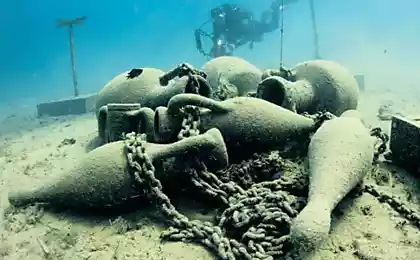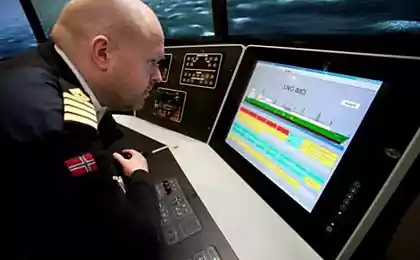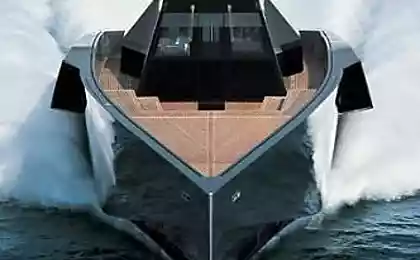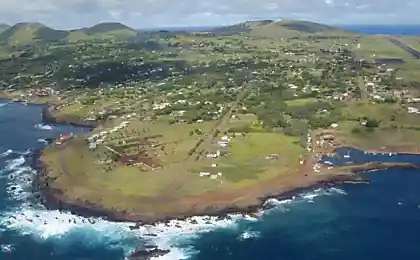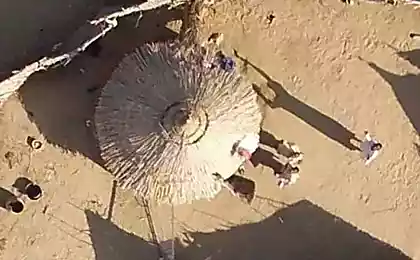2317
Atlantis
Atlantis - is mysterious, a million times repeated in the scientific literature and the word, sometimes disappears and rises again from oblivion, a symbol of the eternal quest of man, searching the real and imaginary roots of human civilization.

At this point in scientific circles as either completely invented by Plato philosophical myth, or - a myth-written based on memories of some ancient catastrophe supposedly breakthrough Mediterranean waters in the Black Sea at the end of the 4th millennium BC. e. or volcanic eruption on the island of Santorini in the middle of the XV century. BC. e. In this case, a pseudo-scientific circles Atlantis is the subject of a variety of hypotheses. Atlantis has become a popular subject of art, fiction. Perhaps this ancient civilization was much more developed than the rest.

The legend of Atlantis was born in ancient Greece, and more than two thousand years excites imagination of people. The legend of the Bermuda Triangle has no such ancient roots. Atlantis problem affects the whole layer of historical knowledge and science mysteries of the Bermuda Triangle smaller - they are reduced to the analysis of natural phenomena and processes on a relatively small portion of the world's oceans.
Literature about Atlantis vast - from popular fiction and mystical works to purely scientific works. Many sources provide information about Atlantis and its possible whereabouts, from the standpoint of modern science.
(Black points - places in which various researchers placed Atlantis.)
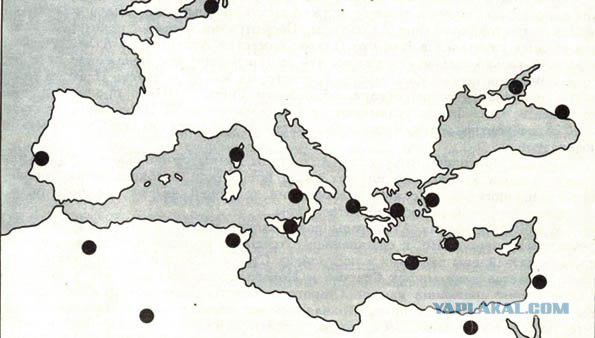
All information contained on Atlantis by Plato in two dialogues "Timaeus" (briefly) and "Critias" (a maximized).

Dialogue "Timaeus" starts arguments of Socrates and the Pythagorean Timaeus about the best state structure. Briefly described the ideal state, Socrates complains of abstractness and schematic picture obtained and expressed a desire to "listen to the description of how this state behaves in the struggle with other nations, as it is worthy of his way enters the war, during the war, as its citizens make it, that they should be, according to their training and education, whether on the battlefield or in negotiations with each of the other states. " In response to this request, the third participant in the dialogue, the Athenian politician Critias presents the story of the war with Athens, Atlantis, supposedly from the words of his grandfather Critias, Sr., who, in turn, told him the story of Solon, hear the latest from the priests in Egypt. The meaning of the story is this: once, 9000 years ago, Athens was the most glorious, powerful and virtuous state. Their main rival was mentioned Atlantis. "This island is greater than its size Libya and Asia put together." It appeared "remarkably in size and power of the kingdom," which owned the whole of Libya to Egypt and Europe to Tirrenia (west Italy). All the forces of the kingdom were thrown on the enslavement of Athens. The Athenians came to the defense of their freedom, led the Greeks; and although all the allies they have changed, they are alone because of their valor and virtue repelled the invasion, crushed the Atlanteans and freed enslaved their people. After that, however, there has been immense natural disaster, which resulted in the per night and killed all the army of the Athenians, and Atlantis sank to the seabed.

Dialogue "Critias", with the same participants, is a direct continuation of the "Timaeus" and entirely devoted to the story of Critias of ancient Athens and Atlantis. Athens then (before the earthquake and flooding) were the center of a large and unusually fertile country; they were inhabited by virtuous people enjoy perfect (in terms of Plato's) government. Namely, all disposed of rulers and warriors who lived separately from the main agricultural and artisan masses on the Acropolis communist community. Modest and virtuous Athens contrasted haughty and mighty Atlantis. The ancestor of Atlantis, according to Plato, was the god Poseidon, descended from the mortal girl Klein, who bore him ten divine sons, headed by senior, Atlanta, between which he divided the island and who became the ancestors of his royal birth. Center of the island is a hill located in 50 stages (8-9 km) from the sea. Poseidon for protection obnёs its three water and two ground rings; Atlanteans also slung over these rings bridges and dug canals, so that the ships could swim up to him on the city itself, or, more precisely, to the central island who had 5 stages (less than a few kilometers) in diameter. On the island towered churches, lined with silver and gold and surrounded by golden statues, magnificent royal palace, and were filled with ships and shipyards t. E., And t. N. "The island on which stood the palace, and the earthen ring and bridge width in plethra (30 m.) kings circled circular stone walls and bridges in the passages to the sea placed throughout the towers and gates. Stone white, black and red, they hunted in the depths of the median island and in the interior of the outer and inner rings of earth and stone quarries, where the two sides remained deepening overlayed on top of the same stone, they arranged parking for vehicles. If some of their buildings, they do simple, others for fun, they skillfully combined stones of different colors, giving them a natural beauty; and also around the outer wall of earth they ring around the circumference they wrought in copper, causing the metal in a molten state, the wall of the inner shaft covered casting of tin, and the walls of the acropolis - orichalcum emitting fiery shining. "

Atlantis in the Atlantic Ocean.
Pillars of Heracles (vellum Phoenician "pillars Melkarta") in antiquity always called the Strait of Gibraltar (and ourselves - the rock of Gibraltar and Ceuta). Thus, Plato places Atlantis directly over the Strait of Gibraltar, off the coast of Spain and Morocco today. Morocco among the Greeks, as a country in the far west - the seat of the titan Atlas (Atlas), which dates back to the name of the name of the ocean and the Atlas mountain range; certainly to him the same dates and the name of Atlantis - "the country of Atlanta" (later in the dialogue "Critias," Plato calls Atlantis first king of the country, and it displays the name of, but originally, apparently, the name meant simply "a country that lies in the far west" ).

Atlantis in the Mediterranean Sea.
Some researchers believe that Plato was wrong in pointing out areas of Atlantis. If we take the area of Atlantis on the order of less, it can be associated with the island of Crete in the Mediterranean Sea. Existed on Crete and neighboring islands ancient Minoan civilization was destroyed really natural disasters (volcanic explosion on the island of Fira, Santorini modern name). Thus did the Minoans had military confrontations with the Achaeans, who inhabited mainland Greece (since actively engaged in piracy). And did the Minoans were defeated by the Achaeans, though not to a natural disaster, but only after it.

Circumpontic region (Black Sea)
There is a hypothesis, wherein said Plato 9000 years are interpreted as the 9000 season at 121-122 days. In this case, the events associated with Atlantis can be attributed to the end of the IV millennium BC and are tied to events such as the collapse of Indo-European community and the beginning of large-scale expansion of Indo-European. Geographically, all of these events are tied to the regions adjacent to the Black Sea, the level of which in this period dramatically increased by almost 100 meters due to the breakthrough of the Bosphorus Mediterranean waters. The most obvious signs of this catastrophe are as the very name of the sea and its unique two-layer structure.

Conducted archaeological and geological work on the island of Santorini in the Aegean Sea and the coast of the island of Crete, as well as research in the area of Ampere Seamount in the Atlantic Ocean.
The excavations of the Greek archaeologist Spyridon Marinatos on Santorini and Crete, and geophysical studies of the catastrophic eruption of the volcano strongyles, what occurred 3,500 years ago, gave food for discussions about the possible existence of Atlantis Mediterranean.
Santorini (Mediterranean) a few decades ago began to talk about Atlantis, tying her with archaeological finds. Professor, University of Athens A. Galanopoulos wrote several works, which provides evidence of the existence of Atlantis in the Aegean Sea. He believed that the state of Atlantis was located on the island of Santorini and Crete. Responding to opponents, refers to the fact that the creator of Atlantis, the ancient Greek philosopher Plato, specifies the location of the mythical island or the mainland, for the Pillars of Hercules (the Strait of Gibraltar rocks) resulted Galanopoulos ancient sources, in which as the pillars of Hercules mentioned the two most southern headland Peloponnese. Geomorphological survey in the caldera and around the island showed that once the diameter of Santorini (then it was called "strongyles", which means "round") was greater than the current 6 km. In the spring of 1967, archaeologists led by Marinatos launched a broad front excavation. They found the whole city, buried under a thick layer of volcanic ash. It was a city of skilled artisans, craftsmen and artists who painted the walls of houses with flowers, birds and animals. It is believed that the city has lived for at least 30 000 people. According Greek scholars, ancient civilization perished in the eruption of the volcano. The surface of the island was covered with a layer of lava and ash. Inside the volcano a void, and the whole central part of the island-volcano collapsed under the weight of the lava. Eruption strongyles and earthquake triggered a huge tsunami that struck the coast of Crete. Flowering gardens and fields on Crete were covered with ashes, environmental disaster occurred. The exact date of the eruption on the island of Santorini is difficult to establish. The opinions of experts differ. One group of researchers believe that this happened in 1410 BC. e. (± 100 years), the other - in 1559 BC. e. (± 44).

More than 50 years ago, a prominent Soviet geographer Berg hypothesized the existence of a large land of Atlantis, in the Aegean Sea, but did not associate it with Santorini.
Just in Article VI of the Soviet oceanographer Eaglet "GeraklOstrov Santorinovy Pillars of Atlantis" Eaglet B. believes that "Pillars" had not called the rock of Gibraltar, and the rocks that are in the Tunisian Strait between the island of Sicily and Africa. Moreover, referring to Eratosthenes, he wrote that the Sicilian channel during the Trojan War was not navigable. The cause of the non-navigational strait B. Eaglet said lower water level in the Mediterranean Sea (the effects of the ice age). So, if the western and eastern Mediterranean Sea were divided, then the fleet Atlanteans could act against the Greeks, the Achaeans only in the eastern part of the sea. In other words, Atlantis was located within the Eastern Mediterranean. Plato placed his Atlantis somewhere near the Pillars of Heracles. B. Eaglet, retreating in the text of Plato puts the legendary island in the Aegean Sea, in the area of the Cyclades. Here is what he wrote: "Given the current shallowness of the Aegean Sea in the area of the Cyclades, where the only one in the Mediterranean, an active volcano of Santorini, one can assume that 3500 years ago on the site of the archipelago could have extensive land. Within this large; generally flat island could easily accommodate a large part of the population of the metropolitan cities and the state of Atlantis. After the explosion, and the eruption of Santorini island partially sunk to form during the subsequent sea-level rise archipelago. Inability to swim in the sea near the submerged island of Atlantis, commemorated by Plato, because he was blocked to the same layer of volcanic ash multimeter ».

It was the same research in the Atlantic Ocean near Ampere Seamount, part of the archipelago underwater Horseshoes, located 300 miles west of Gibraltar, as at a depth of 50-100 m were detected with the outlines of the city ramparts. The top of Mount Ampere was examined by observers in 1979 by a manned submersible "Pisces", the first time coming down here from the ship "Akademik Kurchatov" - the flagship of the Soviet oceanographic fleet. Then observers have concluded that the "wall", made of stone, actually a natural formation. Taken manipulator geological samples from the conglomerates of rounded pebbles eloquently testified to the fact that during the last glaciation, when sea level was lower than at present about 150 meters of the mountain out of the water. While Ampere seamount was a small island of approximately 6 square kilometers, which is too small to host the powerful state of Atlantis.
(A group of seamounts with seamount Ampere right)

In June 1981, during the voyage of the research vessel "Akademik Mstislav Keldysh" was filmed using a towed underwater vehicle equipped with a TV camera, a small television film about Mount Amps. The unit falls on depth, very close to the surface of the seamount, not only over the top of her, but over the slopes. Geological samples were taken, but no trace of human presence and activity on Mount Ampere found.
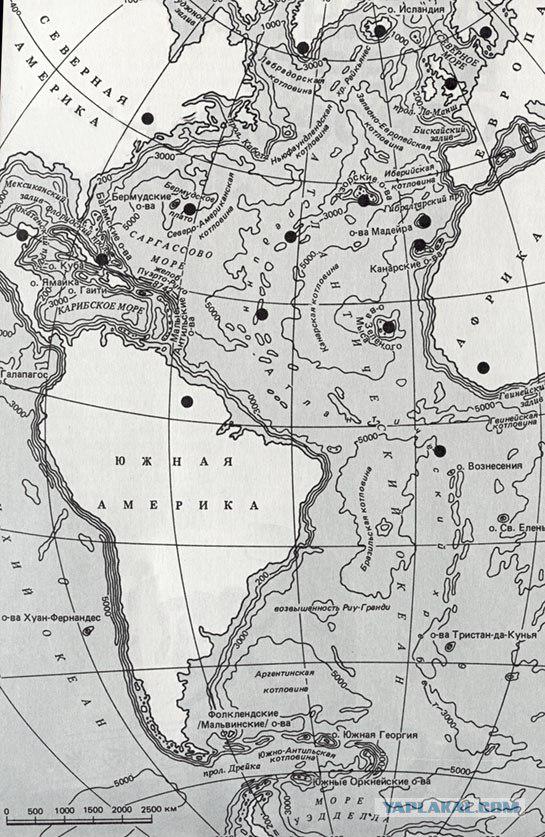
In early 2009, after the launch of Google Earth at the new service Ocean, designed to view the seabed by several users at the bottom of the Atlantic Ocean between the Strait of Gibraltar and the Azores archipelago was discovered by a specific image that resembles a snapshot of the city streets from a great height.

Some researchers came to the conclusion that the island described by Plato not
could exist, so Plato invented it.
Reasons that do not allow the existence of Atlantis follows:
1. The dimensions of the island are too large and specialists geographers can not specify it
more or less plausible location.
2. Geology and Oceanography not support lowering the large island.
3. Not found significant mention of Atlantis.
4. 10 000 years ago could not be developed culture

Source:

At this point in scientific circles as either completely invented by Plato philosophical myth, or - a myth-written based on memories of some ancient catastrophe supposedly breakthrough Mediterranean waters in the Black Sea at the end of the 4th millennium BC. e. or volcanic eruption on the island of Santorini in the middle of the XV century. BC. e. In this case, a pseudo-scientific circles Atlantis is the subject of a variety of hypotheses. Atlantis has become a popular subject of art, fiction. Perhaps this ancient civilization was much more developed than the rest.

The legend of Atlantis was born in ancient Greece, and more than two thousand years excites imagination of people. The legend of the Bermuda Triangle has no such ancient roots. Atlantis problem affects the whole layer of historical knowledge and science mysteries of the Bermuda Triangle smaller - they are reduced to the analysis of natural phenomena and processes on a relatively small portion of the world's oceans.
Literature about Atlantis vast - from popular fiction and mystical works to purely scientific works. Many sources provide information about Atlantis and its possible whereabouts, from the standpoint of modern science.
(Black points - places in which various researchers placed Atlantis.)

All information contained on Atlantis by Plato in two dialogues "Timaeus" (briefly) and "Critias" (a maximized).

Dialogue "Timaeus" starts arguments of Socrates and the Pythagorean Timaeus about the best state structure. Briefly described the ideal state, Socrates complains of abstractness and schematic picture obtained and expressed a desire to "listen to the description of how this state behaves in the struggle with other nations, as it is worthy of his way enters the war, during the war, as its citizens make it, that they should be, according to their training and education, whether on the battlefield or in negotiations with each of the other states. " In response to this request, the third participant in the dialogue, the Athenian politician Critias presents the story of the war with Athens, Atlantis, supposedly from the words of his grandfather Critias, Sr., who, in turn, told him the story of Solon, hear the latest from the priests in Egypt. The meaning of the story is this: once, 9000 years ago, Athens was the most glorious, powerful and virtuous state. Their main rival was mentioned Atlantis. "This island is greater than its size Libya and Asia put together." It appeared "remarkably in size and power of the kingdom," which owned the whole of Libya to Egypt and Europe to Tirrenia (west Italy). All the forces of the kingdom were thrown on the enslavement of Athens. The Athenians came to the defense of their freedom, led the Greeks; and although all the allies they have changed, they are alone because of their valor and virtue repelled the invasion, crushed the Atlanteans and freed enslaved their people. After that, however, there has been immense natural disaster, which resulted in the per night and killed all the army of the Athenians, and Atlantis sank to the seabed.

Dialogue "Critias", with the same participants, is a direct continuation of the "Timaeus" and entirely devoted to the story of Critias of ancient Athens and Atlantis. Athens then (before the earthquake and flooding) were the center of a large and unusually fertile country; they were inhabited by virtuous people enjoy perfect (in terms of Plato's) government. Namely, all disposed of rulers and warriors who lived separately from the main agricultural and artisan masses on the Acropolis communist community. Modest and virtuous Athens contrasted haughty and mighty Atlantis. The ancestor of Atlantis, according to Plato, was the god Poseidon, descended from the mortal girl Klein, who bore him ten divine sons, headed by senior, Atlanta, between which he divided the island and who became the ancestors of his royal birth. Center of the island is a hill located in 50 stages (8-9 km) from the sea. Poseidon for protection obnёs its three water and two ground rings; Atlanteans also slung over these rings bridges and dug canals, so that the ships could swim up to him on the city itself, or, more precisely, to the central island who had 5 stages (less than a few kilometers) in diameter. On the island towered churches, lined with silver and gold and surrounded by golden statues, magnificent royal palace, and were filled with ships and shipyards t. E., And t. N. "The island on which stood the palace, and the earthen ring and bridge width in plethra (30 m.) kings circled circular stone walls and bridges in the passages to the sea placed throughout the towers and gates. Stone white, black and red, they hunted in the depths of the median island and in the interior of the outer and inner rings of earth and stone quarries, where the two sides remained deepening overlayed on top of the same stone, they arranged parking for vehicles. If some of their buildings, they do simple, others for fun, they skillfully combined stones of different colors, giving them a natural beauty; and also around the outer wall of earth they ring around the circumference they wrought in copper, causing the metal in a molten state, the wall of the inner shaft covered casting of tin, and the walls of the acropolis - orichalcum emitting fiery shining. "

Atlantis in the Atlantic Ocean.
Pillars of Heracles (vellum Phoenician "pillars Melkarta") in antiquity always called the Strait of Gibraltar (and ourselves - the rock of Gibraltar and Ceuta). Thus, Plato places Atlantis directly over the Strait of Gibraltar, off the coast of Spain and Morocco today. Morocco among the Greeks, as a country in the far west - the seat of the titan Atlas (Atlas), which dates back to the name of the name of the ocean and the Atlas mountain range; certainly to him the same dates and the name of Atlantis - "the country of Atlanta" (later in the dialogue "Critias," Plato calls Atlantis first king of the country, and it displays the name of, but originally, apparently, the name meant simply "a country that lies in the far west" ).

Atlantis in the Mediterranean Sea.
Some researchers believe that Plato was wrong in pointing out areas of Atlantis. If we take the area of Atlantis on the order of less, it can be associated with the island of Crete in the Mediterranean Sea. Existed on Crete and neighboring islands ancient Minoan civilization was destroyed really natural disasters (volcanic explosion on the island of Fira, Santorini modern name). Thus did the Minoans had military confrontations with the Achaeans, who inhabited mainland Greece (since actively engaged in piracy). And did the Minoans were defeated by the Achaeans, though not to a natural disaster, but only after it.

Circumpontic region (Black Sea)
There is a hypothesis, wherein said Plato 9000 years are interpreted as the 9000 season at 121-122 days. In this case, the events associated with Atlantis can be attributed to the end of the IV millennium BC and are tied to events such as the collapse of Indo-European community and the beginning of large-scale expansion of Indo-European. Geographically, all of these events are tied to the regions adjacent to the Black Sea, the level of which in this period dramatically increased by almost 100 meters due to the breakthrough of the Bosphorus Mediterranean waters. The most obvious signs of this catastrophe are as the very name of the sea and its unique two-layer structure.

Conducted archaeological and geological work on the island of Santorini in the Aegean Sea and the coast of the island of Crete, as well as research in the area of Ampere Seamount in the Atlantic Ocean.
The excavations of the Greek archaeologist Spyridon Marinatos on Santorini and Crete, and geophysical studies of the catastrophic eruption of the volcano strongyles, what occurred 3,500 years ago, gave food for discussions about the possible existence of Atlantis Mediterranean.
Santorini (Mediterranean) a few decades ago began to talk about Atlantis, tying her with archaeological finds. Professor, University of Athens A. Galanopoulos wrote several works, which provides evidence of the existence of Atlantis in the Aegean Sea. He believed that the state of Atlantis was located on the island of Santorini and Crete. Responding to opponents, refers to the fact that the creator of Atlantis, the ancient Greek philosopher Plato, specifies the location of the mythical island or the mainland, for the Pillars of Hercules (the Strait of Gibraltar rocks) resulted Galanopoulos ancient sources, in which as the pillars of Hercules mentioned the two most southern headland Peloponnese. Geomorphological survey in the caldera and around the island showed that once the diameter of Santorini (then it was called "strongyles", which means "round") was greater than the current 6 km. In the spring of 1967, archaeologists led by Marinatos launched a broad front excavation. They found the whole city, buried under a thick layer of volcanic ash. It was a city of skilled artisans, craftsmen and artists who painted the walls of houses with flowers, birds and animals. It is believed that the city has lived for at least 30 000 people. According Greek scholars, ancient civilization perished in the eruption of the volcano. The surface of the island was covered with a layer of lava and ash. Inside the volcano a void, and the whole central part of the island-volcano collapsed under the weight of the lava. Eruption strongyles and earthquake triggered a huge tsunami that struck the coast of Crete. Flowering gardens and fields on Crete were covered with ashes, environmental disaster occurred. The exact date of the eruption on the island of Santorini is difficult to establish. The opinions of experts differ. One group of researchers believe that this happened in 1410 BC. e. (± 100 years), the other - in 1559 BC. e. (± 44).

More than 50 years ago, a prominent Soviet geographer Berg hypothesized the existence of a large land of Atlantis, in the Aegean Sea, but did not associate it with Santorini.
Just in Article VI of the Soviet oceanographer Eaglet "GeraklOstrov Santorinovy Pillars of Atlantis" Eaglet B. believes that "Pillars" had not called the rock of Gibraltar, and the rocks that are in the Tunisian Strait between the island of Sicily and Africa. Moreover, referring to Eratosthenes, he wrote that the Sicilian channel during the Trojan War was not navigable. The cause of the non-navigational strait B. Eaglet said lower water level in the Mediterranean Sea (the effects of the ice age). So, if the western and eastern Mediterranean Sea were divided, then the fleet Atlanteans could act against the Greeks, the Achaeans only in the eastern part of the sea. In other words, Atlantis was located within the Eastern Mediterranean. Plato placed his Atlantis somewhere near the Pillars of Heracles. B. Eaglet, retreating in the text of Plato puts the legendary island in the Aegean Sea, in the area of the Cyclades. Here is what he wrote: "Given the current shallowness of the Aegean Sea in the area of the Cyclades, where the only one in the Mediterranean, an active volcano of Santorini, one can assume that 3500 years ago on the site of the archipelago could have extensive land. Within this large; generally flat island could easily accommodate a large part of the population of the metropolitan cities and the state of Atlantis. After the explosion, and the eruption of Santorini island partially sunk to form during the subsequent sea-level rise archipelago. Inability to swim in the sea near the submerged island of Atlantis, commemorated by Plato, because he was blocked to the same layer of volcanic ash multimeter ».

It was the same research in the Atlantic Ocean near Ampere Seamount, part of the archipelago underwater Horseshoes, located 300 miles west of Gibraltar, as at a depth of 50-100 m were detected with the outlines of the city ramparts. The top of Mount Ampere was examined by observers in 1979 by a manned submersible "Pisces", the first time coming down here from the ship "Akademik Kurchatov" - the flagship of the Soviet oceanographic fleet. Then observers have concluded that the "wall", made of stone, actually a natural formation. Taken manipulator geological samples from the conglomerates of rounded pebbles eloquently testified to the fact that during the last glaciation, when sea level was lower than at present about 150 meters of the mountain out of the water. While Ampere seamount was a small island of approximately 6 square kilometers, which is too small to host the powerful state of Atlantis.
(A group of seamounts with seamount Ampere right)

In June 1981, during the voyage of the research vessel "Akademik Mstislav Keldysh" was filmed using a towed underwater vehicle equipped with a TV camera, a small television film about Mount Amps. The unit falls on depth, very close to the surface of the seamount, not only over the top of her, but over the slopes. Geological samples were taken, but no trace of human presence and activity on Mount Ampere found.

In early 2009, after the launch of Google Earth at the new service Ocean, designed to view the seabed by several users at the bottom of the Atlantic Ocean between the Strait of Gibraltar and the Azores archipelago was discovered by a specific image that resembles a snapshot of the city streets from a great height.

Some researchers came to the conclusion that the island described by Plato not
could exist, so Plato invented it.
Reasons that do not allow the existence of Atlantis follows:
1. The dimensions of the island are too large and specialists geographers can not specify it
more or less plausible location.
2. Geology and Oceanography not support lowering the large island.
3. Not found significant mention of Atlantis.
4. 10 000 years ago could not be developed culture

Source:

